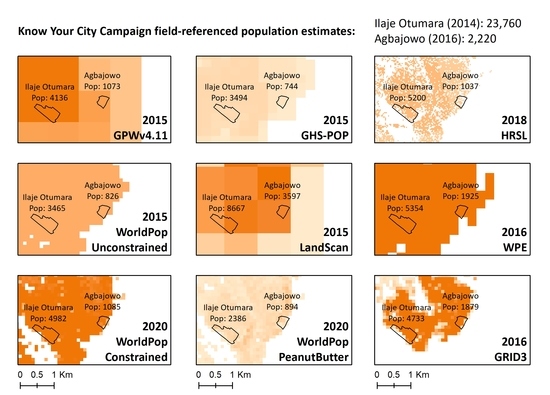Evaluating the Accuracy of Gridded Population Estimates in Slums: A Case Study in Nigeria and Kenya
Abstract
1. Introduction
2. Materials and Methods
2.1. Setting
2.2. Data
2.2.1. Know Your City Deprived Area Boundaries and Population Counts
2.2.2. Lagos Slum Map
2.2.3. Gridded Population Estimates
| Dataset | Producer | Year | Resolution | Coverage | Method | Citation |
|---|---|---|---|---|---|---|
| Top-down: Un-modelled: Unconstrained | ||||||
| GPWv4.11 | CIESIN, Columbia University | 2015, 2020 | 30 arc sec (~1 km2) | Residential | Equal allocation of population to cells within census unit (areal weighting on edge cells) | [44,45] |
| Top-down: Lightly modelled: Constrained | ||||||
| GHS-POP | European Commission, Joint Research Centre (JRC) | 2015 | 9 arc sec (~250 m2) | Residential | Binary dasymetric, proportional allocation to built-up areas extracted from 30 m Landsat imagery | [46,47] |
| HRSL | Facebook Connectivity Lab and CIESIN | 2018 | 1 arc sec (~30 m2) | Residential | Binary dasymetric, proportional to houses/settlements extracted from 0.5 m Digital Globe imagery | [49] |
| Top-down: Highly modelled: Unconstrained | ||||||
| WorldPop- Unconstrained | WorldPop, Univ. of Southampton | 2015, 2018 | 3 arc sec (~100 m2) | Residential | Random Forrest model with 24 covariates and dasymetric redistribution | [53,63] |
| Top-down: Highly modelled: Constrained | ||||||
| LandScan | Oak Ridge National Laboratory | 2015, 2018 | 30 arc sec (~1 km2) | Ambient (24-h average) | Multivariable dasymetric model with 4 covariate types and bespoke weight layer | [50,51] |
| WPE | ESRI | 2016 | 162 m | Residential | Dasymetric algorithm with 16 inputs | [52] |
| World-Pop-Constrained | WorldPop, Univ. of Southampton | 2020 | 3 arc sec (~100 m2) | Residential | Random Forrest model with 24 covariates and dasymetric redistribution constrained to cells with buildings in Africa and urban extents elsewhere | [64,65] |
| Bottom-up: Un-modelled: Constrained | ||||||
| WorldPop-PeanutButter | WorldPop, Univ. of Southampton | ~2018 | 3 arc sec (~100 m2) | Residential | Based on Ecopia building footprints, average household size, and 2 building parameters | [58] |
| Bottom-up: Highly modelled: Constrained | ||||||
| GRID3 (Nigeria v1.2) | CIESIN, WorldPop, Flowminder, UNFPA, BMGF, DFID | 2016 | 3 arc sec (~100 m2) | Residential | Hierarchical Bayesian model with 6 covariates and trained on a sample of 3-hectare microcensus population counts | [60,66] |
2.3. Data Checks and Processing
2.4. Analysis One: Comparison of Gridded Population Estimates and KYC Field Reports
2.5. Analysis Two: Comparison of Gridded Population Estimates for SDG 11 Monitoring in Lagos
2.6. Ethics
3. Results
3.1. Analysis One: Comparison of Gridded Population Estimates and KYC Field Reports
3.2. Analysis Two: Comparison of Gridded Population Estimates for SDG 11 Monitoring in Lagos
4. Discussion
4.1. Recommendations for Un-Modelled and Lightly Modelled Gridded Population Datasets
4.1.1. GPWv4.11
4.1.2. WorldPop-Peanut Butter
4.1.3. GHS-POP
4.1.4. HRSL
4.2. Recommendations for Highly Modelled Gridded Population Datasets
4.2.1. Cross-Cutting: Fine-Scale Urban Covariates
4.2.2. WorldPop-Unconstrained
4.2.3. WorldPop-Constrained
4.2.4. LandScan Global
4.2.5. WPE
4.3. Limitations
4.4. Broadening Accuracy Assessments of Gridded Population Estimates in Slums
5. Conclusions
Author Contributions
Funding
Institutional Review Board Statement
Informed Consent Statement
Data Availability Statement
Acknowledgments
Conflicts of Interest
Appendix A. Visuals of Data Cleaning and Data Checks
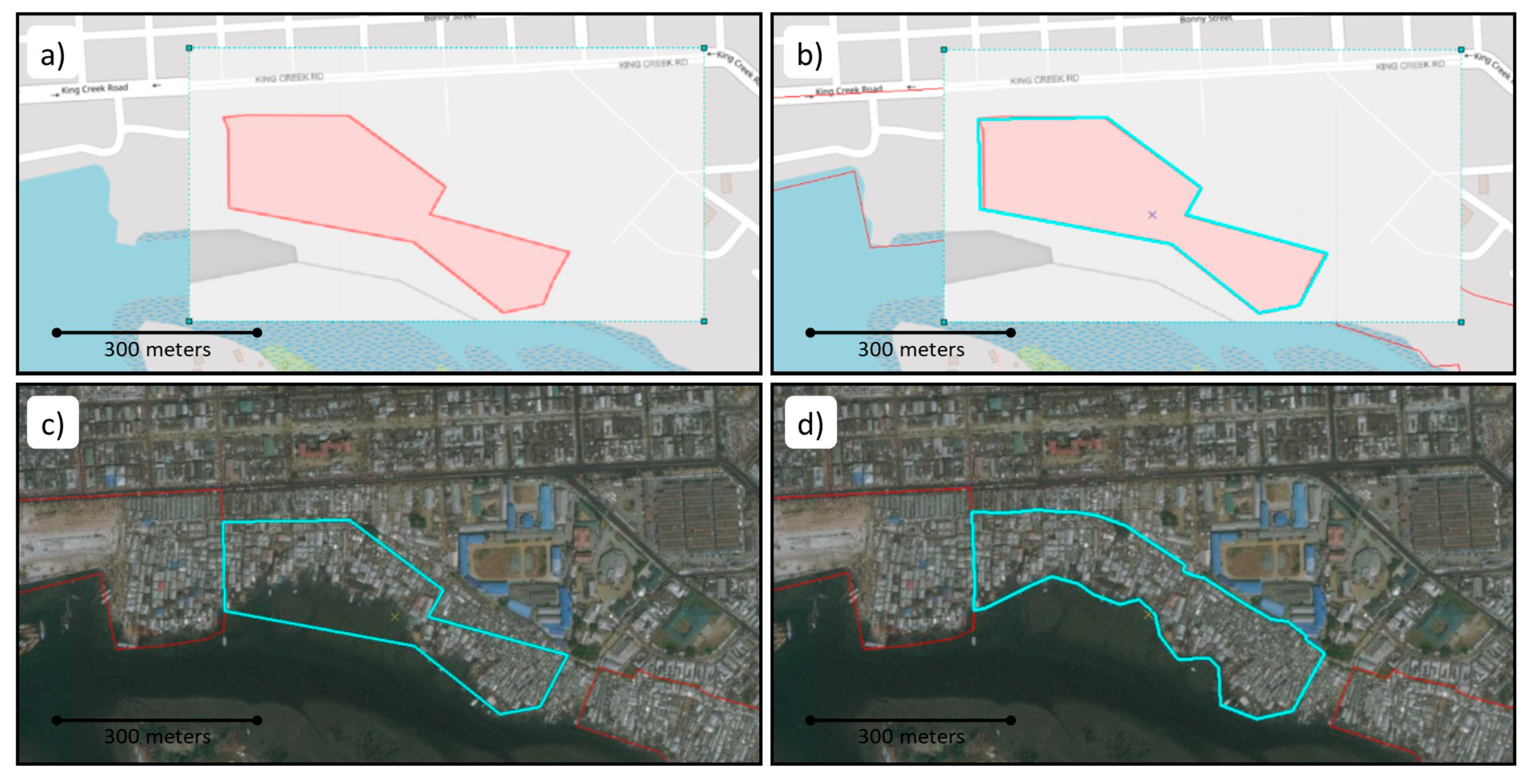
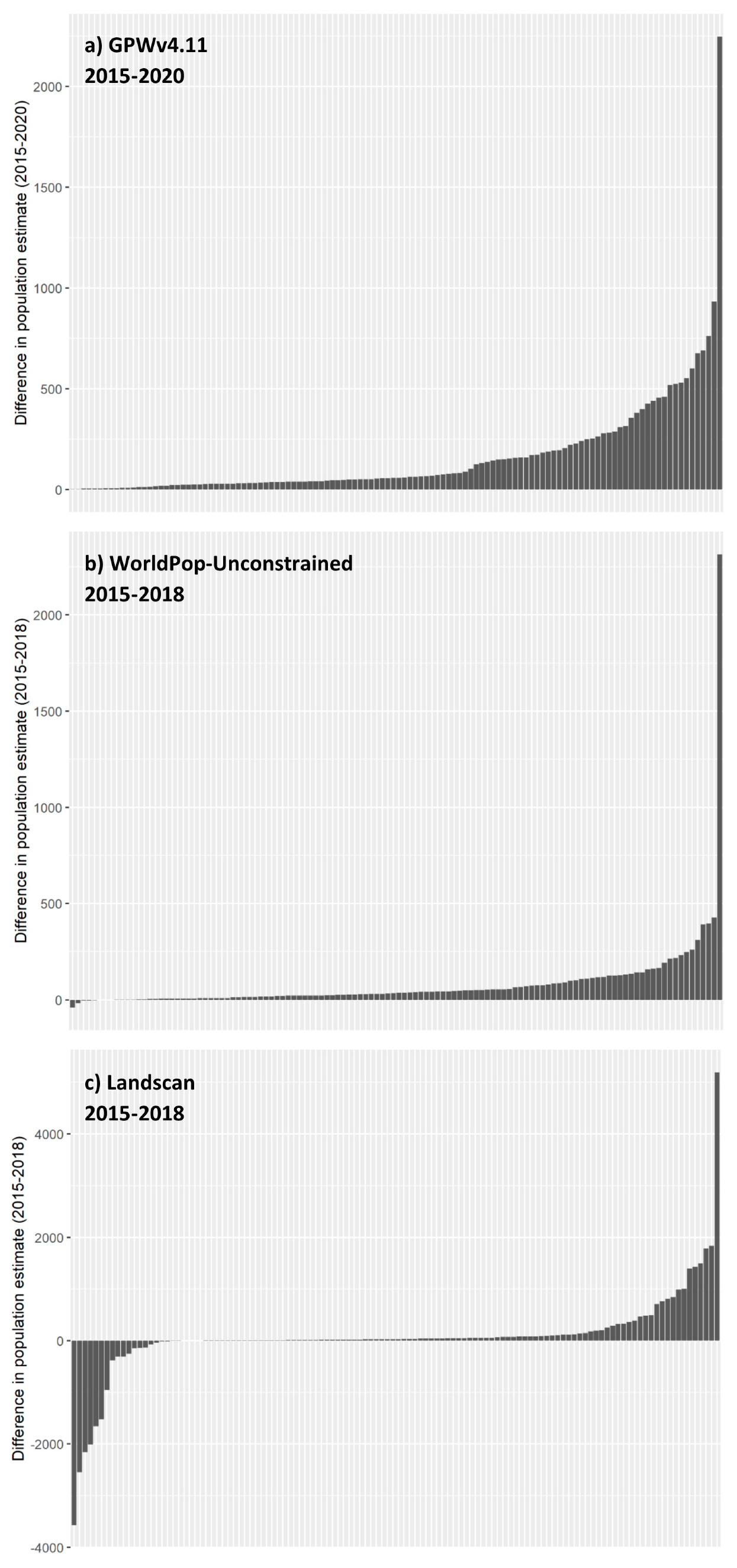
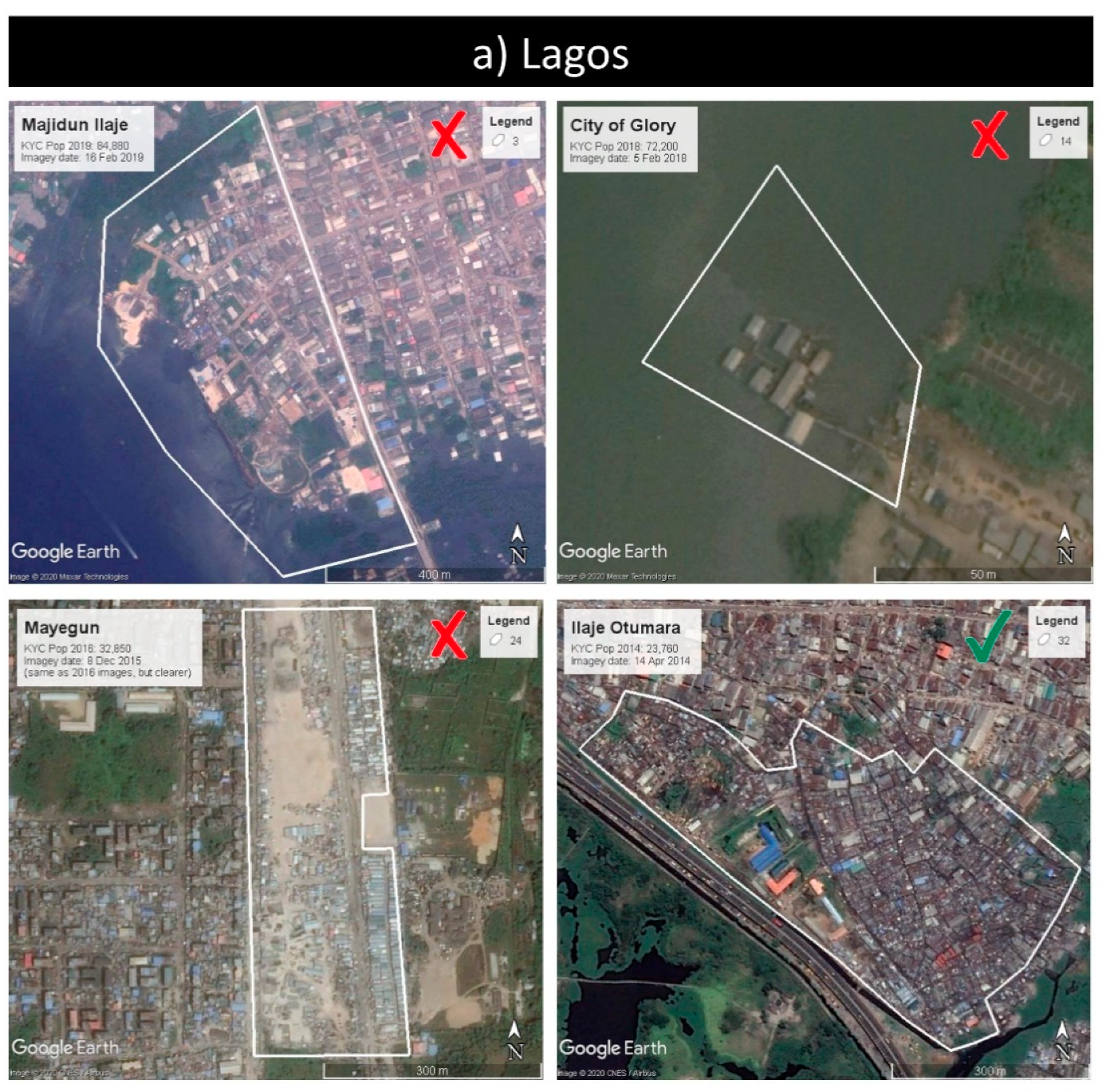
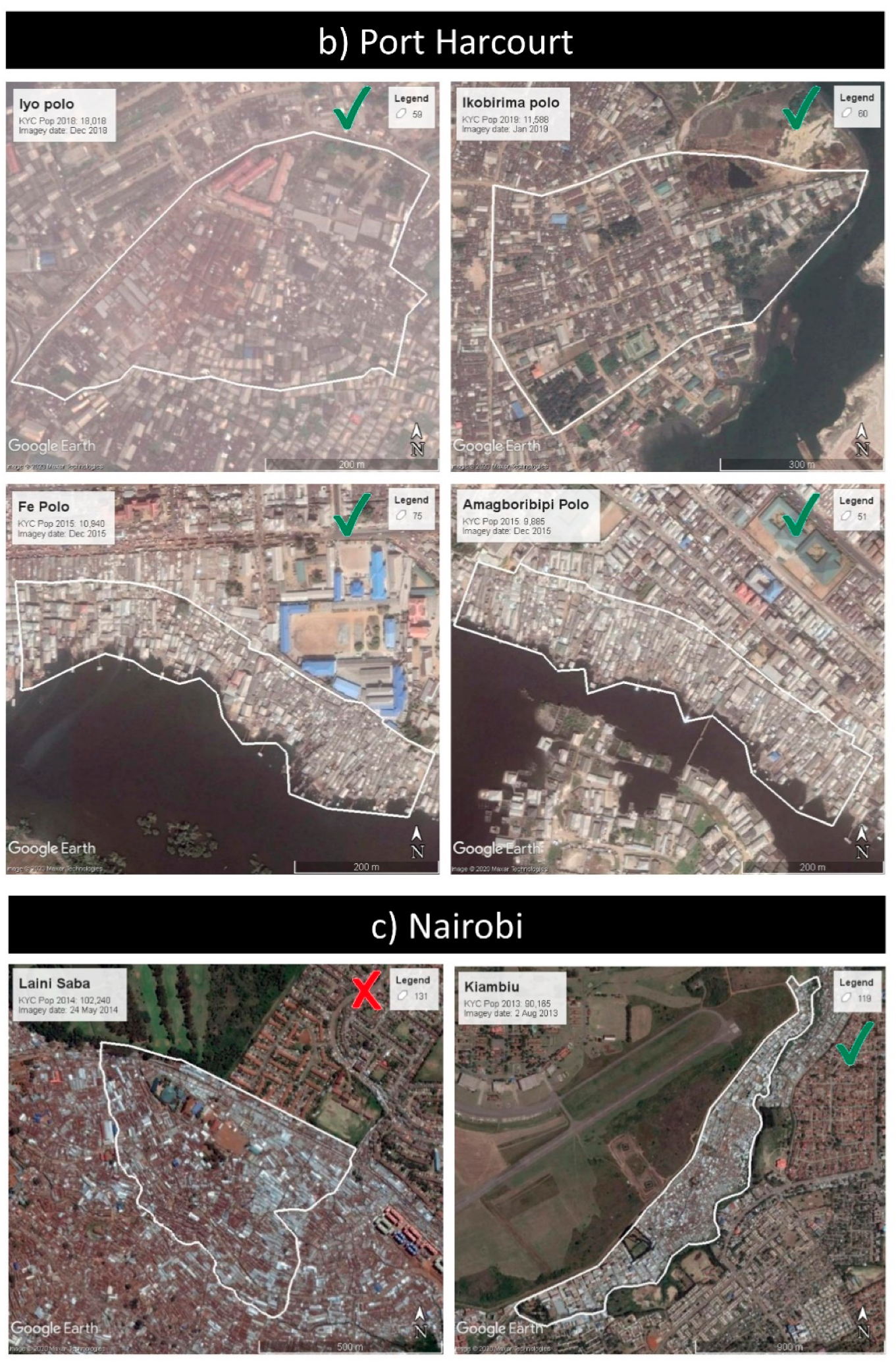
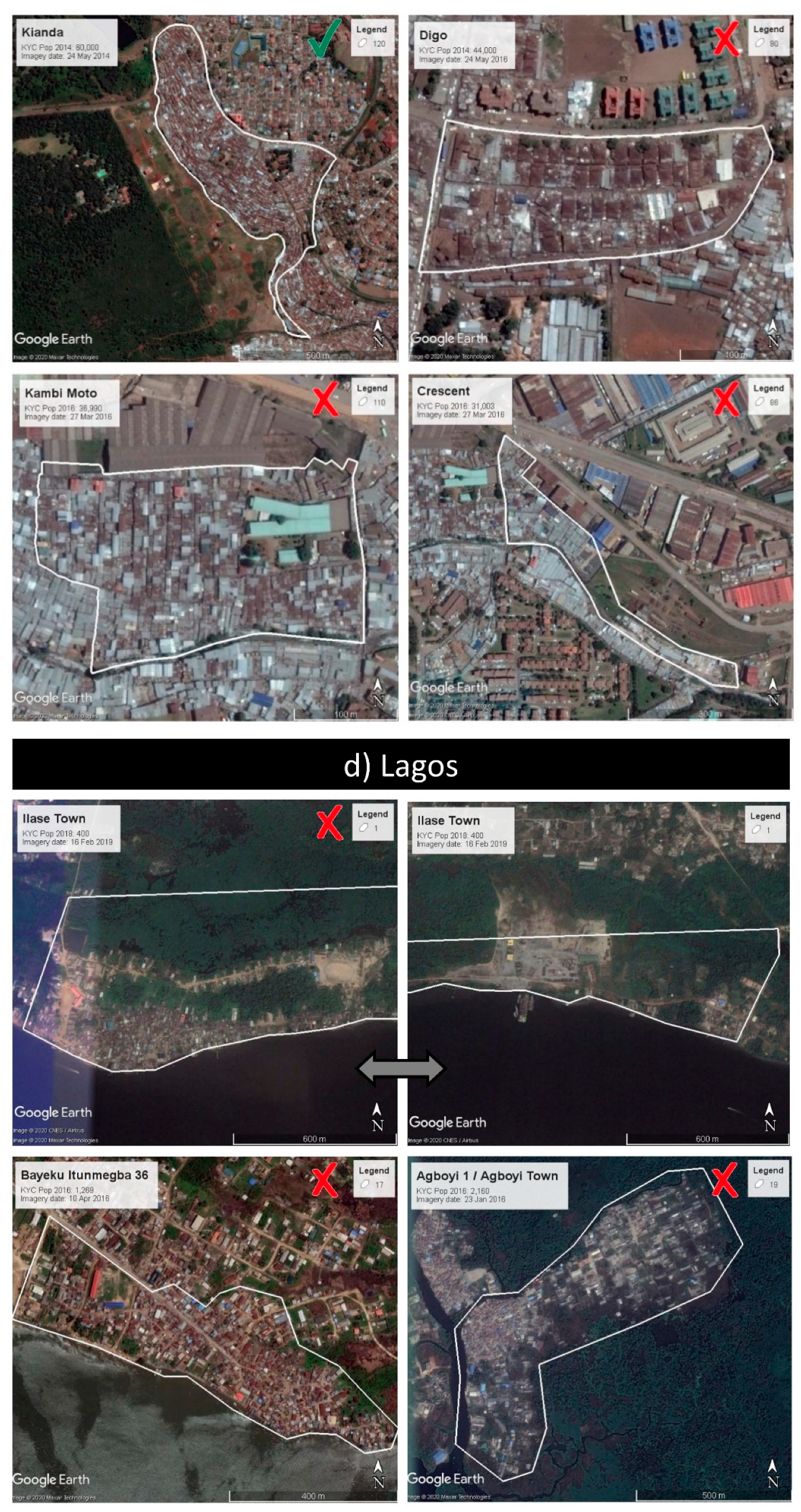
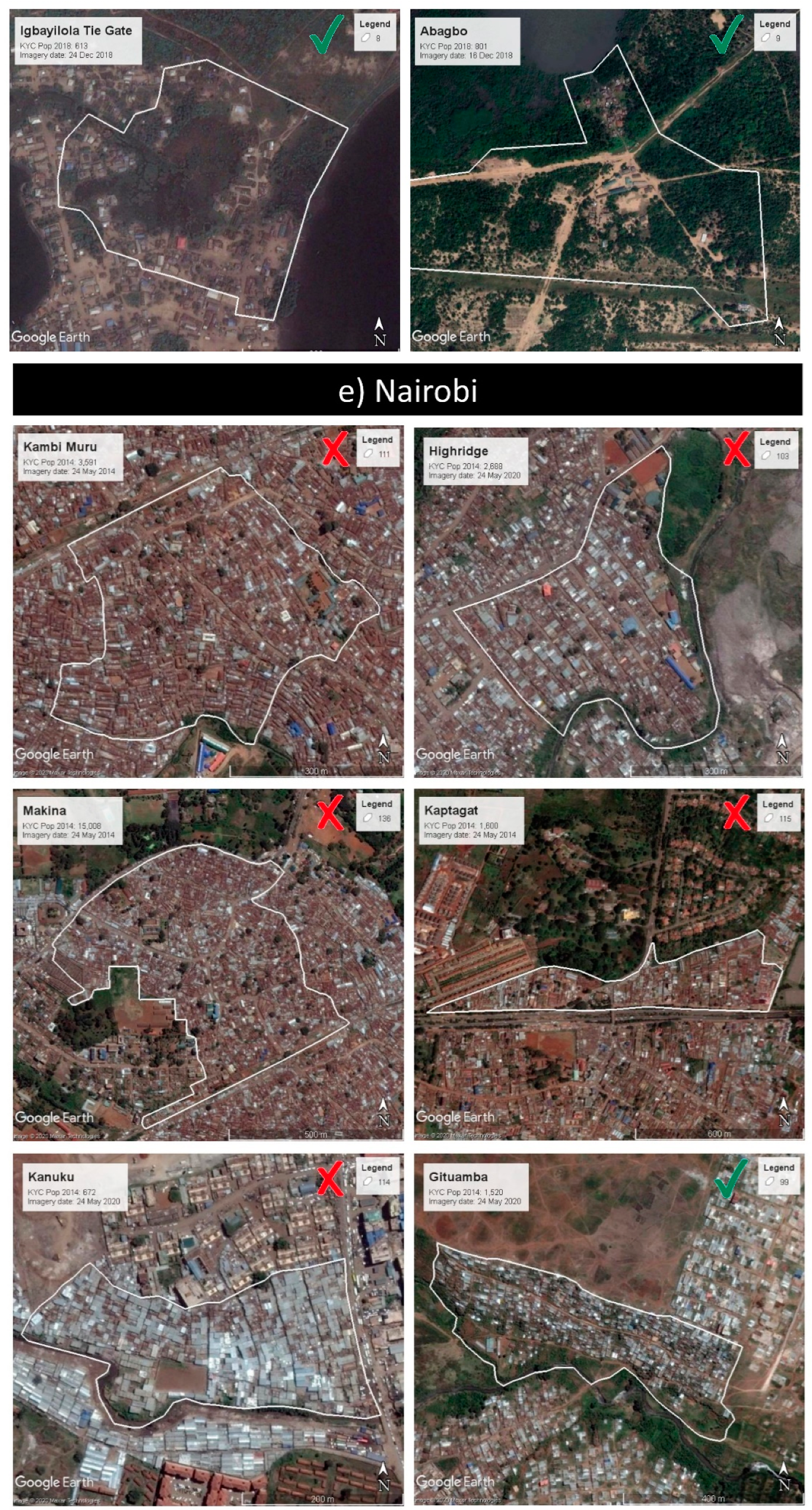
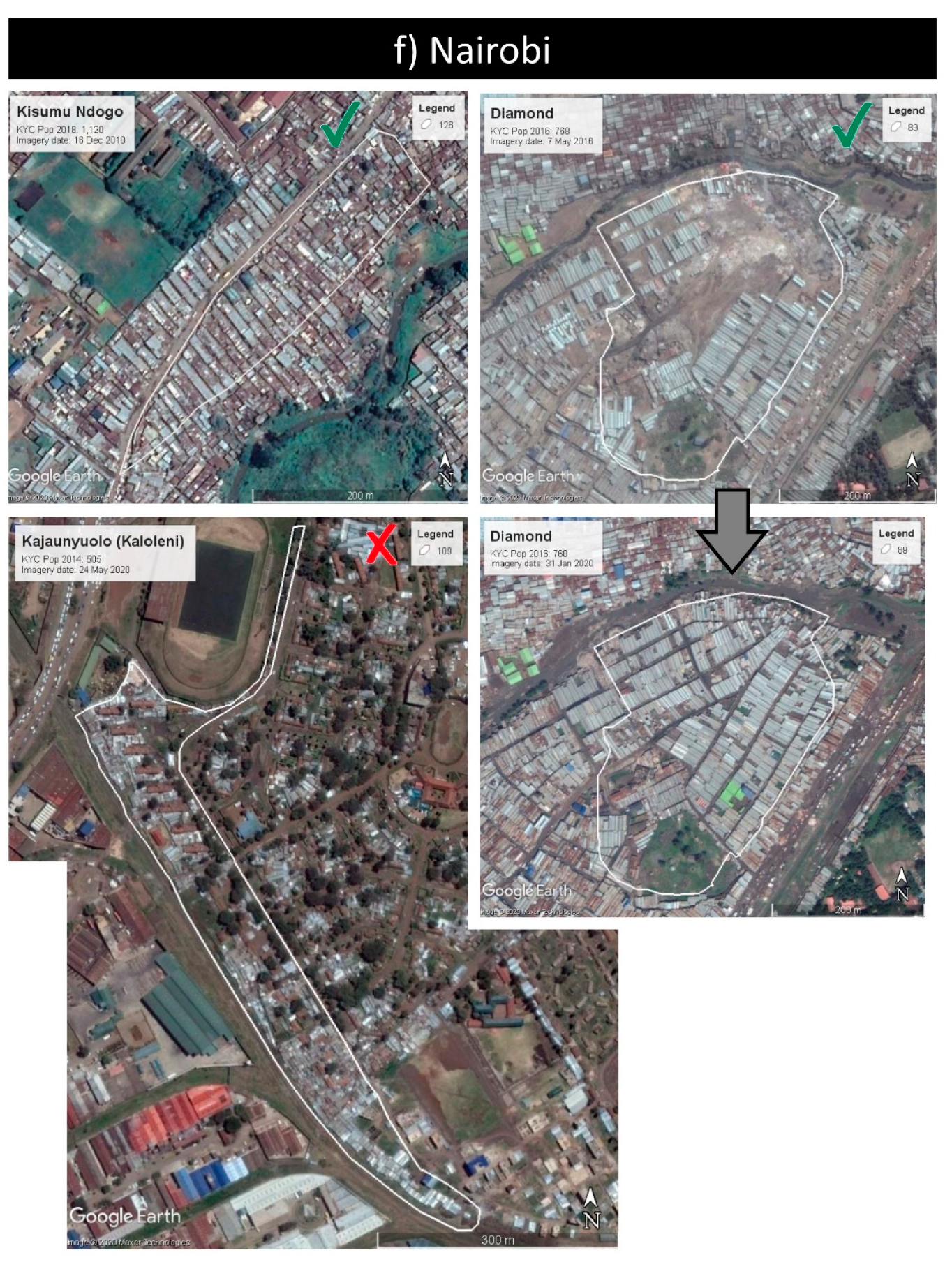
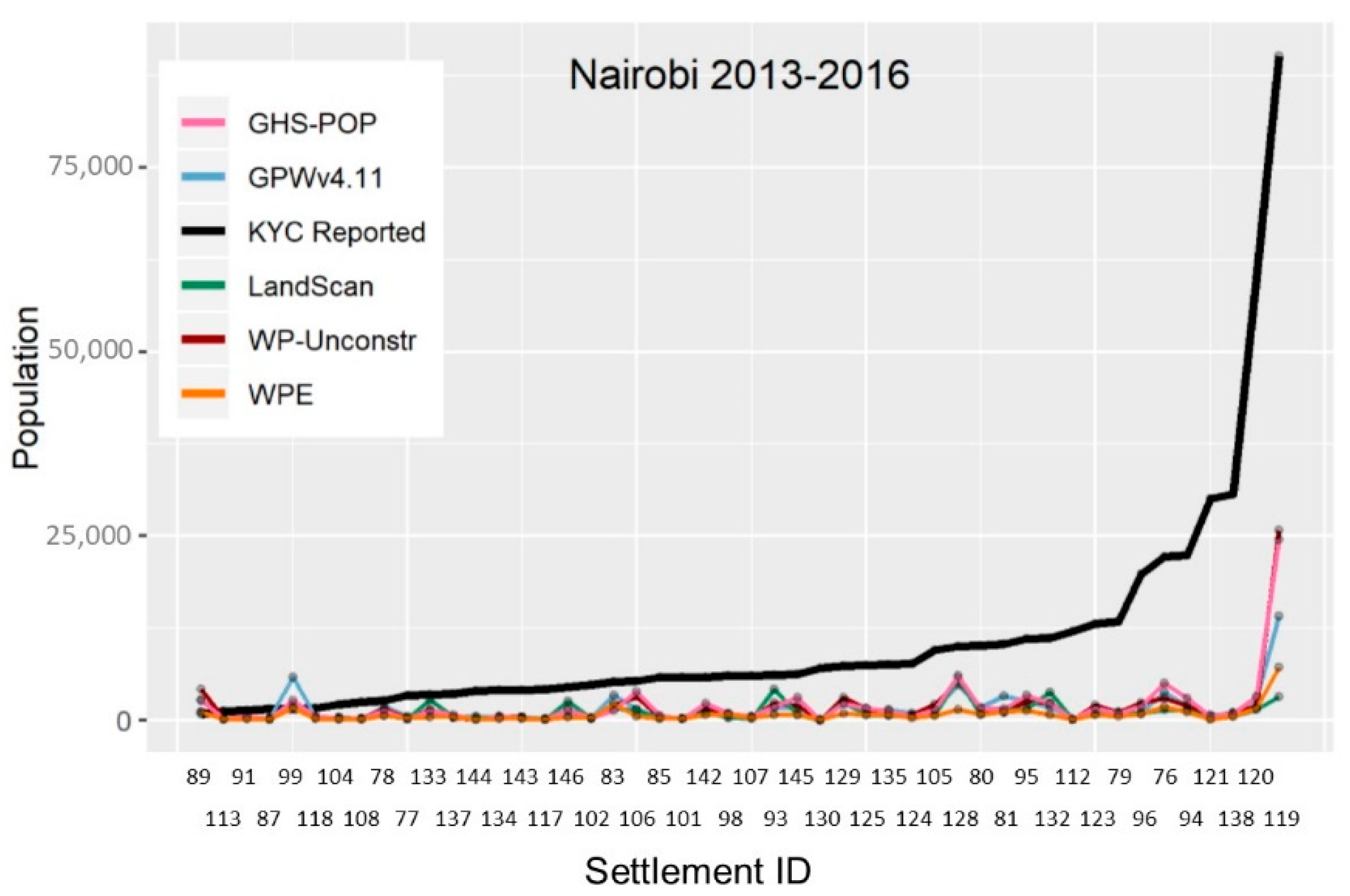
| Community ID | City | KYC Reported Area (m2) | Digitized Area (m2) | Percent Differences |
|---|---|---|---|---|
| 25 | Lagos | 33,872 | 330,010 | −89.7 |
| 17 | Lagos | 121,403 | 198,646 | −38.9 |
| 5 | Lagos | 28,327 | 44,746 | −36.7 |
| 23 | Lagos | 327,789 | 498,470 | −34.2 |
| 26 | Lagos | 27,672 | 38,420 | −28.0 |
| 4 | Lagos | 19,898 | 26,625 | −25.3 |
| 12 | Lagos | 28,327 | 37,590 | −24.6 |
| 24 | Lagos | 92,509 | 118,020 | −21.6 |
| 35 | Lagos | 32,374 | 39,431 | −17.9 |
| 28 | Lagos | 137,591 | 165,710 | −17.0 |
| 29 | Lagos | 28,327 | 32,712 | −13.4 |
| 6 | Lagos | 52,608 | 60,694 | −13.3 |
| 8 | Lagos | 153,778 | 163,400 | −5.9 |
| 30 | Lagos | 291,368 | 298,186 | −2.3 |
| 32 | Lagos | 190,199 | 189,849 | 0.2 |
| 33 | Lagos | 28,327 | 26,042 | 8.8 |
| 31 | Lagos | 153,778 | 141,365 | 8.8 |
| 9 | Lagos | 586,783 | 503,458 | 16.6 |
| 21 | Lagos | 352,070 | 250,463 | 40.6 |
| 27 | Lagos | 145,684 | 96,509 | 51.0 |
| 71 | Port Harcourt | 13,795 | 20,051 | −31.2 |
| 69 | Port Harcourt | 7049 | 10,194 | −30.8 |
| 62 | Port Harcourt | 4621 | 5941 | −22.2 |
| 43 | Port Harcourt | 7491 | 9356 | −19.9 |
| 45 | Port Harcourt | 27,320 | 32,139 | −15.0 |
| 44 | Port Harcourt | 29,117 | 33,625 | −13.4 |
| 75 | Port Harcourt | 62,616 | 70,861 | −11.6 |
| 36 | Port Harcourt | 44,515 | 49,549 | −10.2 |
| 67 | Port Harcourt | 6548 | 7144 | −8.3 |
| 72 | Port Harcourt | 37,570 | 40,358 | −6.9 |
| 64 | Port Harcourt | 30,925 | 33,172 | −6.8 |
| 56 | Port Harcourt | 7110 | 7171 | −0.8 |
| 51 | Port Harcourt | 72,842 | 68,571 | 6.2 |
| 117 | Nairobi | 4741 | 149,083 | −96.8 |
| 121 | Nairobi | 53,529 | 586,783 | −90.9 |
| 91 | Nairobi | 7439 | 48,157 | −84.6 |
| 110 | Nairobi | 49,193 | 182,105 | −73.0 |
| 106 | Nairobi | 32,812 | 60,702 | −45.9 |
| 128 | Nairobi | 89,081 | 153,778 | −42.1 |
| 145 | Nairobi | 65,136 | 105,216 | −38.1 |
| 126 | Nairobi | 57,587 | 89,758 | −35.8 |
| 147 | Nairobi | 8765 | 12,140 | −27.8 |
| 108 | Nairobi | 8915 | 12,140 | −26.6 |
| 119 | Nairobi | 423,363 | 526,608 | −19.6 |
| 88 | Nairobi | 35,124 | 40,468 | −13.2 |
| 77 | Nairobi | 15,602 | 17,280 | −9.7 |
| 132 | Nairobi | 76,640 | 83,849 | −8.6 |
| 105 | Nairobi | 64,001 | 69,605 | −8.0 |
| 90 | Nairobi | 30,999 | 32,374 | −4.2 |
| 81 | Nairobi | 96,137 | 99,199 | −3.1 |
| 83 | Nairobi | 159,054 | 161,871 | −1.7 |
| 135 | Nairobi | 55,933 | 56,655 | −1.3 |
| 78 | Nairobi | 52,032 | 52,608 | −1.1 |
| 137 | Nairobi | 30,443 | 30,756 | −1.0 |
| 146 | Nairobi | 43,381 | 43,705 | −0.7 |
| 93 | Nairobi | 72,434 | 72,842 | −0.6 |
| 111 | Nairobi | 173,058 | 174,012 | −0.5 |
| 136 | Nairobi | 305,970 | 307,555 | −0.5 |
| 129 | Nairobi | 93,447 | 93,885 | −0.5 |
| 100 | Nairobi | 80,568 | 80,936 | −0.5 |
| 120 | Nairobi | 173,564 | 174,012 | −0.3 |
| 124 | Nairobi | 20,274 | 20,234 | 0.2 |
| 112 | Nairobi | 16,246 | 16,187 | 0.4 |
| 144 | Nairobi | 42,350 | 40,468 | 4.7 |
| 95 | Nairobi | 116,941 | 109,668 | 6.6 |
| 103 | Nairobi | 129,265 | 116,588 | 10.9 |
| 104 | Nairobi | 6010 | 5220 | 15.1 |
| 143 | Nairobi | 8224 | 7001 | 17.5 |
| 79 | Nairobi | 44,319 | 36,421 | 21.7 |
| 87 | Nairobi | 29,726 | 24,281 | 22.4 |
| 142 | Nairobi | 39,994 | 31,646 | 26.4 |
| 107 | Nairobi | 16,169 | 12,140 | 33.2 |
| 138 | Nairobi | 37,017 | 27,113 | 36.5 |
| 99 | Nairobi | 124,886 | 89,029 | 40.3 |
| 134 | Nairobi | 5689 | 4047 | 40.6 |
| 113 | Nairobi | 18,638 | 12,140 | 53.5 |
| 96 | Nairobi | 76,184 | 48,561 | 56.9 |
| 127 | Nairobi | 53,743 | 32,900 | 63.4 |
| 130 | Nairobi | 13,301 | 7932 | 67.7 |
| 80 | Nairobi | 47,759 | 28,327 | 68.6 |
| 76 | Nairobi | 148,885 | 84,982 | 75.2 |
| 98 | Nairobi | 222,377 | 121,403 | 83.2 |
| 85 | Nairobi | 16,849 | 8094 | 108.2 |
| 86 | Nairobi | 32,818 | 12,140 | 170.3 |
| 109 | Nairobi | 66,206 | 16,187 | 309.0 |
| 114 | Nairobi | 59,619 | 11,048 | 439.6 |
| 94 | Nairobi | 92,362 | 12,140 | 660.8 |
| 123 | Nairobi | 77,888 | 8094 | 862.3 |
| 133 | Nairobi | 47,056 | 4047 | 1062.8 |
| 200 × 200 m Units | Lagos Maximum | Port Harcourt Maximum | Nairobi Maximum |
|---|---|---|---|
| KYC Slum Settlements | 12,123 | 13,885 | 34,760 |
| Citywide | |||
| HRSL (2018) | 4874 | 4175 | 14,771 |
| WP-Constrained (2020) | 4983 | 1220 | 8905 |
| WP-Unconstrained (2018) | 4435 | 656 | 9519 |
| WP-Unconstrained (2015) | 3974 | 582 | 9088 |
| GHS-POP (2015) | 3035 | 1530 | 9403 |
| GPWv4.11 (2020) | 4010 | 226 | 6632 |
| GPWv4.11 (2015) | 3537 | 199 | 5718 |
| LandScan (2015) | 5007 | 1165 | 2782 |
| LandScan (2018) | 4709 | 1230 | 1846 |
| GRID3 (2016) | 3685 | 1128 | n/a |
| WPE (2016) | 2619 | 815 | 1311 |
| WP-PeanutButter (2020) | 1424 | 992 | 866 |
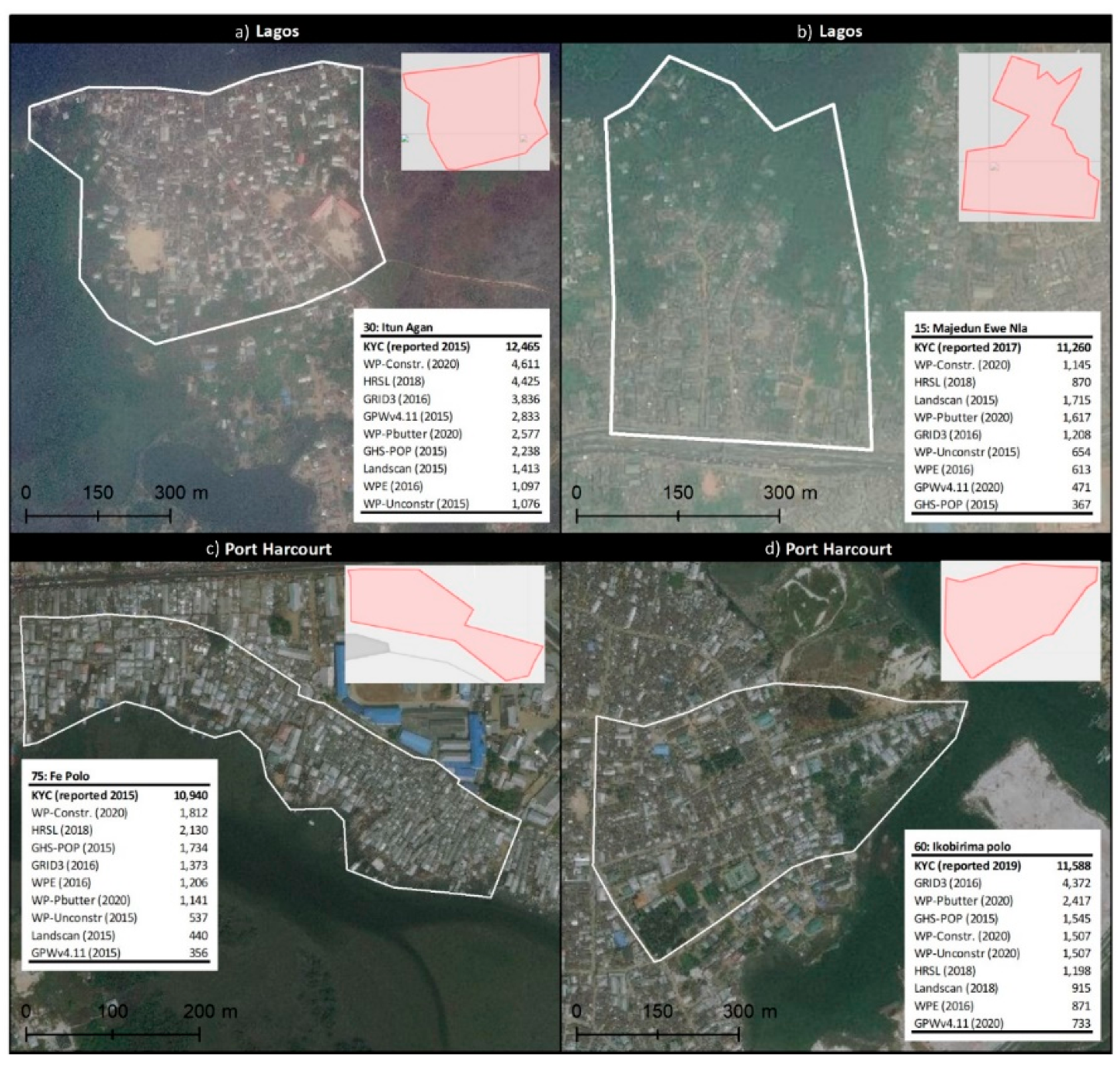
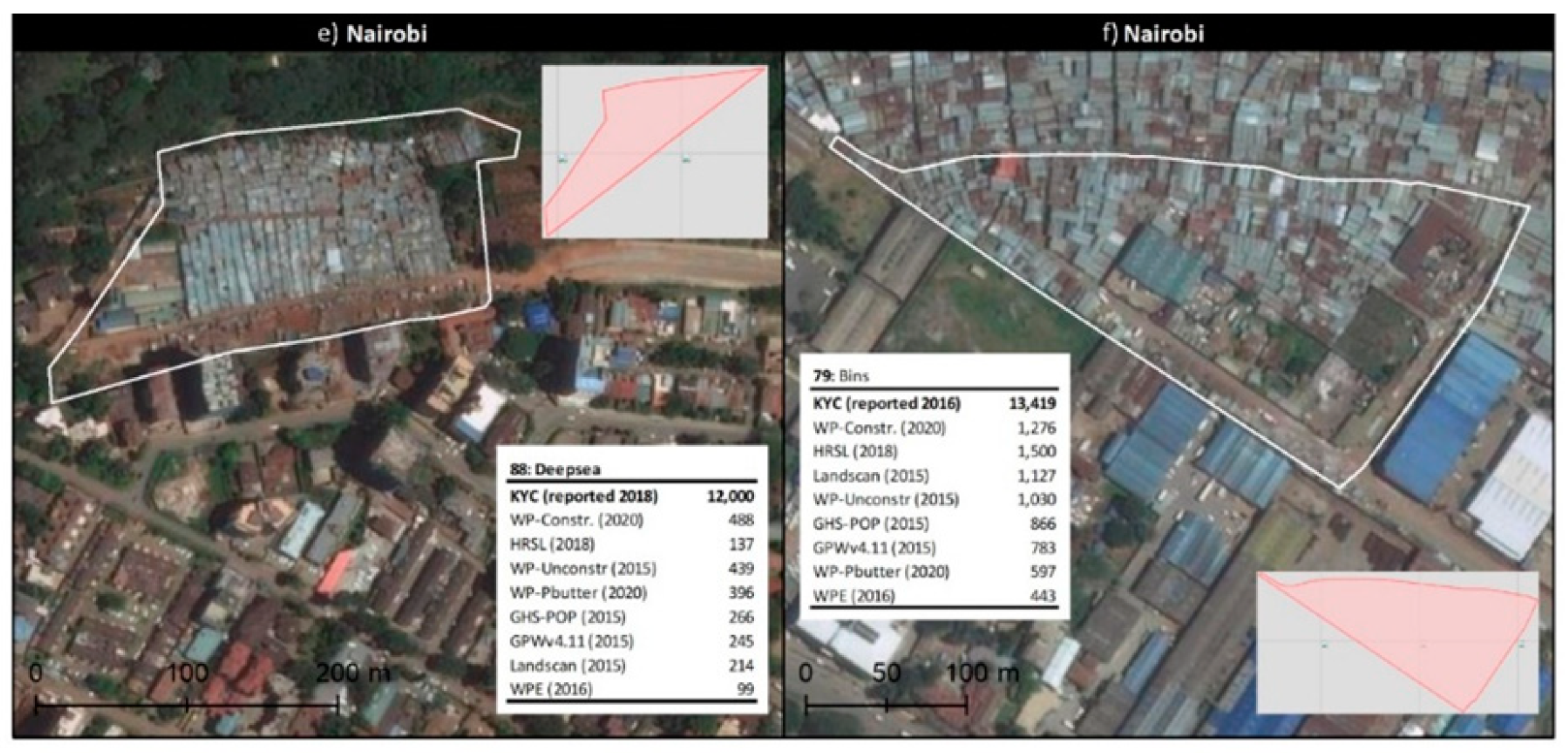

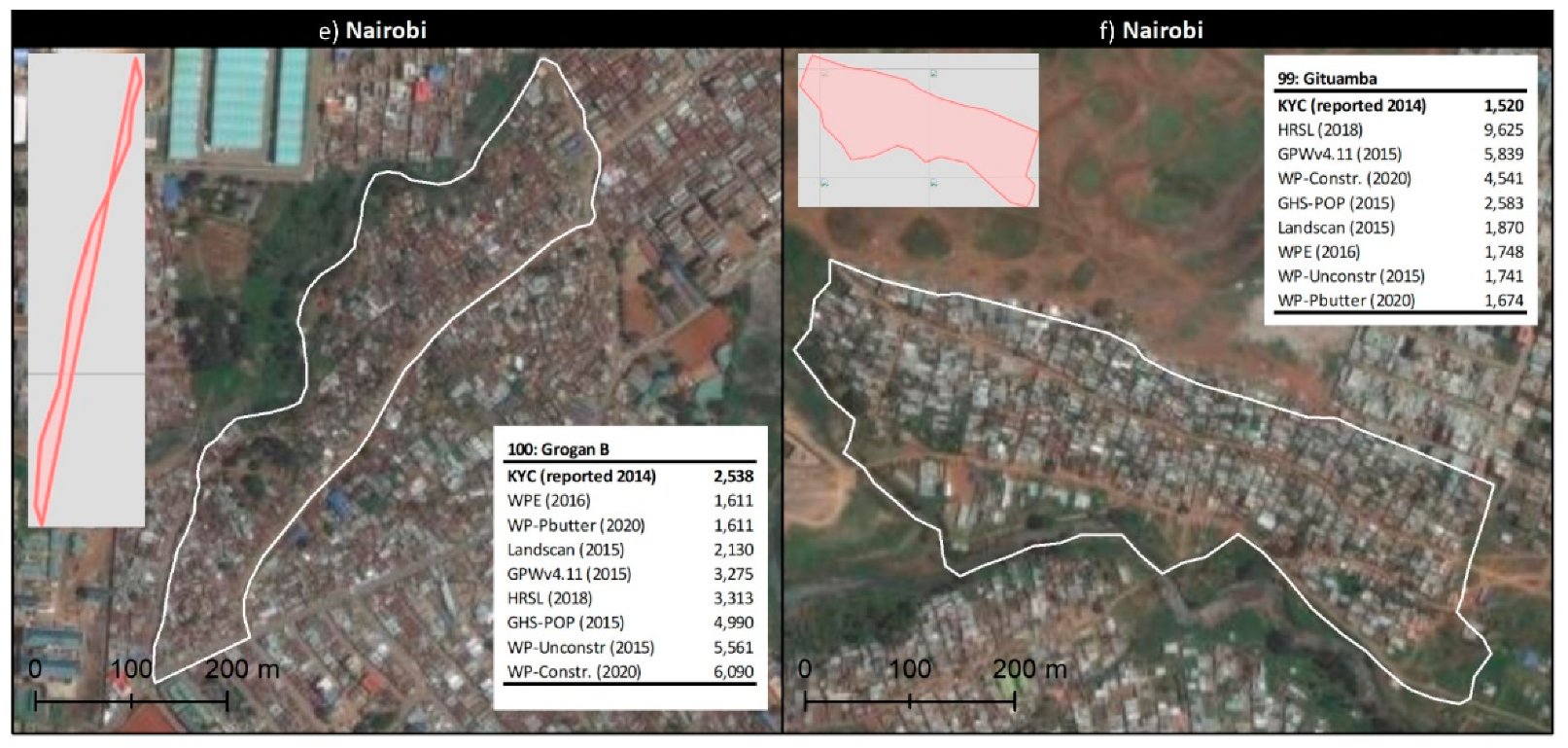
References
- UN Department of Economic and Social Affairs (UN-DESA). World Urbanization Prospects: The 2018 Revision. Available online: https://population.un.org/wup/DataQuery/ (accessed on 13 June 2021).
- Satterthwaite, D. Working Paper No. 2010/28 Urban Myths and the Misuse of Data That Underpin Them; United Nations University World Institute for Development Economics Research: Helsinki Finland, 2010; ISBN 9789292302634. [Google Scholar]
- UN Human Settlements Programme (UN-Habitat). World Cities Report 2020: The Value of Sustainable Urbanization; UN-Habitat: Nairobi, Kenya, 2020; ISBN 9788578110796. [Google Scholar]
- Potts, D. Broken Cities: Inside the Global Housing Crisis; Zed Press: London UK, 2020; ISBN 9781786990549. [Google Scholar]
- Thomson, D.R.; Bhattarai, R.; Khanal, S.; Manandhar, S.; Dhungel, R.; Gajurel, S.; Hicks, J.P.; Duc, D.M.; Ferdoush, J.; Ferdous, T.; et al. Addressing unintentional exclusion of vulnerable and mobile households in traditional surveys in Kathmandu, Dhaka, and Hanoi: A mixed-methods feasibility study. J. Urban Health 2021, 98, 111–129. [Google Scholar] [CrossRef] [PubMed]
- Mahapatra, P.; Shibuya, K.; Lopez, A.D.; Coullare, F.; Notzon, F.C.; Rao, C.; Szreter, S. Civil registration systems and vital statistics: Successes and missed opportunities. Lancet 2007, 370, 1653–1663. [Google Scholar] [CrossRef]
- Lucci, P.; Bhatkal, T.; Khan, A. Are we underestimating urban poverty? World Dev. 2018, 103, 297–310. [Google Scholar] [CrossRef]
- United Nations Statistics Division (UNSD). 2020 World Population and Housing Census Programme. Available online: https://unstats.un.org/unsd/demographic-social/census/censusdates/ (accessed on 13 June 2021).
- Ahonsi, B.A. Deliberate falsification and census-data in Nigeria. Afr. Aff. 1988, 87, 553–562. [Google Scholar] [CrossRef]
- Okolo, A. The Nigerian Census: Problems and prospects. Am. Stat. 1999, 53, 321–325. [Google Scholar]
- Yin, S. Objections Surface over Nigerian Census Results. Available online: www.prb.org/resources/objections-surface-over-nigerian-census-results/ (accessed on 13 June 2021).
- Habitat for Humanity Great Britain the World’s largest slums: Dharavi, Kibera, Khayelitsha & Neza. Available online: www.habitatforhumanity.org.uk/blog/2017/12/the-worlds-largest-slums-dharavi-kibera-khayelitsha-neza/ (accessed on 13 June 2021).
- Kenya National Bureau of Statistics (KNBS). The 2009 Kenya Population and Housing Census—Volume I A; Kenya National Bureau of Statistics (KNBS): Nairobi, Kenya, 2010; ISBN 9789966767202. [Google Scholar]
- Desgroppes, A.; Taupin, S. Kibera: The biggest slum in Africa? East Afr. Rev. 2011, 44, 23–33. [Google Scholar]
- Erulkar, A.S.; Matheka, J.K. Adolescence in the Kibera Slums of Nairobi Kenya. Available online: https://knowledgecommons.popcouncil.org/departments_sbsr-pgy/1212/ (accessed on 13 June 2021).
- Thomson, D.R.; Kuffer, M.; Boo, G.; Hati, B.; Grippa, T.; Elsey, H.; Linard, C.; Mahabir, R.; Kyobutungi, C.; Maviti, J.; et al. Need for an integrated deprived area “slum” mapping system (IDEAMAPS) in low- and middle-income countries (LMICs). Soc. Sci. 2020, 9, 80. [Google Scholar] [CrossRef]
- POPGRID. Data Collaborative POPGRID. Available online: www.popgrid.org (accessed on 13 June 2021).
- Lang, S.; Füreder, P.; Riedler, B.; Wendt, L.; Braun, A.; Tiede, D.; Schoepfer, E.; Zeil, P.; Spröhnle, K.; Kulessa, K.; et al. Earth observation tools and services to increase the effectiveness of humanitarian assistance. Eur. J. Remote Sens. 2020, 53, 67–85. [Google Scholar] [CrossRef]
- Ramadan, R.A. Big Data Tools-An Overview. Int. J. Comput. Softw. Eng. 2017, 2, 125. [Google Scholar] [CrossRef][Green Version]
- Yan, Y.; Feng, C.C.; Huang, W.; Fan, H.; Wang, Y.C.; Zipf, A. Volunteered geographic information research in the first decade: A narrative review of selected journal articles in GIScience. Int. J. Geogr. Inf. Sci. 2020, 34, 1765–1791. [Google Scholar] [CrossRef]
- Utazi, C.E.; Wagai, J.; Pannell, O.; Cutts, F.T.; Rhoda, D.A.; Ferrari, M.J.; Dieng, B.; Oteri, J.; Danovaro-Holliday, M.C.; Adeniran, A.; et al. Geospatial variation in measles vaccine coverage through routine and campaign strategies in Nigeria: Analysis of recent household surveys. Vaccine 2020, 38, 3062–3071. [Google Scholar] [CrossRef] [PubMed]
- Wigley, A.S.; Tejedor-Garavito, N.; Alegana, V.; Carioli, A.; Ruktanonchai, C.W.; Pezzulo, C.; Matthews, Z.; Tatem, A.J.; Nilsen, K. Measuring the availability and geographical accessibility of maternal health services across sub-Saharan Africa. BMC Med. 2020, 18, 1–10. [Google Scholar] [CrossRef]
- De Bono, A.; Mora, M.G. A global exposure model for disaster risk assessment. Int. J. Disaster Risk Reduct. 2014, 10, 442–451. [Google Scholar] [CrossRef]
- Thomson, D.R.; Rhoda, D.A.; Tatem, A.J.; Castro, M.C. Gridded population survey sampling: A systematic scoping review of the field and strategic research agenda. Int. J. Health Geogr. 2020, 19, 34. [Google Scholar] [CrossRef]
- Leyk, S.; Gaughan, A.E.; Adamo, S.B.; de Sherbinin, A.; Balk, D.; Freire, S.; Rose, A.; Stevens, F.R.; Blankespoor, B.; Frye, C.; et al. Allocating people to pixels: A review of large-scale gridded population data products and their fitness for use. Earth Syst. Sci. Data Discuss. 2019, 11, 1385–1409. [Google Scholar] [CrossRef]
- United Nations Department of Economic and Social Affairs (UN-DESA). Sustainable Development Goals. Available online: https://sustainabledevelopment.un.org/sdgs (accessed on 13 June 2021).
- World Population Review (WPR). World Cities. Available online: https://worldpopulationreview.com/world-cities (accessed on 13 June 2021).
- Badmos, O.S.; Callo-Concha, D.; Agbola, B.; Rienow, A.; Badmos, B.; Greve, K.; Jürgens, C. Determinants of residential location choices by slum dwellers in Lagos megacity. Cities 2020, 98, 102589. [Google Scholar] [CrossRef]
- Opoko, A.P.; Oluwatayo, A. Trends in urbanisation: Implication for planning and low-income housing delivery in Lagos, Nigeria. Archit. Res. 2014, 4, 15–26. [Google Scholar]
- Emordi, E.; Osiki, O. Lagos: The ‘villagized’ city. Inf. Soc. Justice J. 2008, 2, 95–109. [Google Scholar]
- Jones, M. Nigeria Housing: “I Live in a Floating Slum” in Lagos. BBC News, 5 March 2020. [Google Scholar]
- Obafemi, A.A.; Odubo, T. V Waterfronts redevelopments in Port Harcourt metropolis: Issues and socio-economic implications for urban environmental management. Int. J. Eng. Sci. 2013, 2, 1–14. [Google Scholar]
- African Population and Health Research Center (APHRC). Population and Health Dynamics in Nairobi’s Informal Settlements: Report of the Nairobi Cross-Sectional Slums Survey (NCSS). 2012. Available online: https://assets.publishing.service.gov.uk/media/57a089f240f0b64974000338/NCSS2-FINAL-Report.pdf (accessed on 13 June 2021).
- Panek, J.; Sobotova, L. Community mapping in urban informal settlements: Examples from Nairobi, Kenya. Electron. J. Inf. Syst. Dev. Ctries. 2015, 68, 1–13. [Google Scholar] [CrossRef]
- Meredith, T.; MacDonald, M.; Kwach, H.; Waikuru, E.; Alabaster, G. Partnerships for successes in slum upgrading: Local governance and social change in Kibera, Nairobi. In Land Issues for Urban Governance in Sub-Saharan Africa; Home, R., Ed.; Springer International Publishing: Chelmsford UK, 2021; pp. 237–255. ISBN 978-3-030-52504-0. [Google Scholar]
- Otiso, K.M. Evictions in Nairobi: Why the City Has a Problem and What Can Be Done to Fix It. Available online: https://theconversation.com/evictions-in-nairobi-why-the-city-has-a-problem-and-what-can-be-done-to-fix-it-100255 (accessed on 13 June 2021).
- Nnoko-Mewanu, J.; Abdi, N. Nairobi Evicts 8000 People amidst a Pandemic and Curfew. Available online: www.hrw.org/news/2020/06/10/nairobi-evicts-8000-people-amidst-pandemic-and-curfew (accessed on 13 June 2021).
- Bhalla, N. Forced Evictions Leave 5000 Kenyan Slum Dwellers at Risk of Coronavirus. Available online: https://uk.reuters.com/article/us-health-coronavirus-kenya-homelessness/forced-evictions-leave-5000-kenyan-slum-dwellers-at-risk-of-coronavirus-idUSKBN22I1VC (accessed on 13 June 2021).
- Slum/Shack Dwellers International (SDI) Know Your City. Available online: http://knowyourcity.info/explore-our-data/ (accessed on 13 June 2021).
- Slum/Shack Dwellers International (SDI) Know Your City: Slum Dwellers Count. Available online: https://sdinet.org/wp-content/uploads/2018/02/SDI_StateofSlums_LOW_FINAL.pdf (accessed on 13 June 2021).
- Badmos, O.; Rienow, A.; Callo-Concha, D.; Greve, K.; Jürgens, C. Simulating slum growth in Lagos: An integration of rule based and empirical based model. Comput. Environ. Urban Syst. 2019, 77, 101369. [Google Scholar] [CrossRef]
- Badmos, O.S.; Rienow, A.; Callo-Concha, D.; Greve, K.; Jürgens, C. Urban development in West Africa-monitoring and intensity analysis of slum growth in Lagos: Linking pattern and process. Remote Sens. 2018, 10, 1044. [Google Scholar] [CrossRef]
- Mennis, J. Generating surface models of population using dasymetric mapping. Prof. Geogr. 2003, 55, 31–42. [Google Scholar]
- Center for International Earth Science Information Network—CIESIN—Columbia University Gridded Population of the World, Version 4.11 (GPWv4.11). Available online: https://doi.org/10.7927/H4F47M65 (accessed on 13 June 2021).
- Doxsey-Whitfield, E.; MacManus, K.; Adamo, S.B.; Pistolesi, L.; Squires, J.; Borkovska, O.; Baptista, S.R. Taking advantage of the improved availability of census data: A first look at the Gridded Population of the World, Version 4. Pap. Appl. Geogr. 2015, 1, 226–234. [Google Scholar] [CrossRef]
- European Commission Joint Research Centre (EC-JRC). Global Human Settlement Population Model (GHS-POP). Available online: https://ghsl.jrc.ec.europa.eu/data.php (accessed on 13 June 2021).
- Pesaresi, M.; Ehrlich, D.; Florczyk, A.J.; Freire, S.; Julea, A.; Kemper, T.; Soille, P.; Syrris, V. Operating Procedure for the Production of the Global Human Settlement Layer from Landsat Data of the Epochs 1975, 1990, 2000, and 2014; European Commission Joint Research Centre: Ispra, Italy, 2016; ISBN 9789279550126. [Google Scholar]
- Tiecke, T.G.; Liu, X.; Zhang, A.; Gros, A.; Li, N.; Yetman, G.; Kilic, T.; Murray, S.; Blankespoor, B.; Prydz, E.B.; et al. Mapping the World Population One Building at a Time. arxiv 2017, arXiv:1712.05839. [Google Scholar]
- Facebook Connectivity Lab; CIESIN—Columbia University High Resolution Settlement Layer (HRSL). Available online: https://data.humdata.org/dataset/highresolutionpopulationdensitymaps (accessed on 13 June 2021).
- Dobson, J.E.; Brlght, E.A.; Coleman, P.R.; Worley, B.A.; Bright, E.A.; Coleman, P.R.; Durfee, R.C.; Worley, B.A. LandScan: A global population database for estimating populations at risk. Photogramm. Eng. Remote Sens. 2000, 66, 849–857. [Google Scholar]
- Oak Ridge National Laboratories (ORNL). LandScan. Available online: https://landscan.ornl.gov/landscan-data-availability (accessed on 13 June 2021).
- Frye, C.; Nordstrand, E.; Wright, D.J.; Terborgh, C.; Foust, J. Using classified and unclassified land cover data to estimate the footprint of human settlement. Data Sci. J. 2018, 17, 1–12. [Google Scholar] [CrossRef]
- Stevens, F.R.; Gaughan, A.E.; Linard, C.; Tatem, A.J. Disaggregating census data for population mapping using random forests with remotely-sensed and ancillary data. PLoS ONE 2015, 10, e0107042. [Google Scholar] [CrossRef]
- Linard, C.; Gilbert, M.; Tatem, A.J. Assessing the use of global land cover data for guiding large area population distribution modelling. GeoJournal 2011, 76, 525–538. [Google Scholar] [CrossRef]
- Lloyd, C.T.; Chamberlain, H.; Kerr, D.; Yetman, G.; Pistolesi, L.; Stevens, F.R.; Gaughan, A.E.; Nieves, J.J.; Hornby, G.; MacManus, K.; et al. Global spatio-temporally harmonised datasets for producing high-resolution gridded population distribution datasets. Big Earth Data 2019, 3, 108–139. [Google Scholar] [CrossRef]
- Maxar Satellite Imagery. Available online: www.maxar.com/products/satellite-imagery (accessed on 13 June 2021).
- Nieves, J.J.; Bondarenko, M.; Sorichetta, A.; Steele, J.E.; Kerr, D.; Carioli, A.; Stevens, F.R.; Gaughan, A.E.; Tatem, A.J. Predicting near-future built-settlement expansion using relative changes in small area populations. Remote Sens. 2020, 12, 1545. [Google Scholar] [CrossRef]
- Leasure, D.R.; Dooley, C.A.; Bondarenko, M.; Tatem, A.J. peanutButter: An R Package to Produce Rapid-Response Gridded Population Estimates from Building Footprints, Version 0.3.0. Available online: https://apps.worldpop.org/peanutButter/ (accessed on 13 June 2021).
- CIESIN; UNFPA; WorldPop; Flowminder. Geo-Referenced Infrastructure and Demographic Data for Development (GRID3). Available online: www.grid3.org (accessed on 13 June 2021).
- Leasure, D.R.; Jochem, W.C.; Weber, E.M.; Seaman, V.; Tatem, A.J. National population mapping from sparse survey data: A hierarchical Bayesian modeling framework to account for uncertainty. Proc. Natl. Acad. Sci. USA 2020, 117, 24173–24179. [Google Scholar] [CrossRef] [PubMed]
- Oak Ridge National Laboratories (ORNL). LandScan HD: Human Settlement Mapping at Global Scale. Available online: www.youtube.com/watch?v=P84vxTT9Vos (accessed on 13 June 2021).
- POPGRID. Global Population Grids: Summary Characteristics. Available online: www.popgrid.org/data-docs-table1 (accessed on 13 June 2021).
- WorldPop. Population Counts 2000–2020 UN-Adjusted Unconstrained 100 m. Available online: www.worldpop.org/geodata/listing?id=69 (accessed on 13 June 2021).
- WorldPop. Population Counts 2020 UN-Adjusted Constrained 100 m. Available online: www.worldpop.org/geodata/listing?id=79 (accessed on 13 June 2021).
- WorldPop. Top-Down Estimation Modelling: Constrained vs. Unconstrained. Available online: www.worldpop.org/methods/top_down_constrained_vs_unconstrained (accessed on 13 June 2021).
- GRID3 [Nigeria]. National Population Estimates v1.2. Available online: https://grid3.org/resources/data (accessed on 13 June 2021).
- National Population Commission (NPC); ICF. International Nigeria Demographic and Health Survey. 2013. Available online: https://dhsprogram.com/pubs/pdf/fr293/fr293.pdf (accessed on 13 June 2021).
- UN Human Settlements Programme (UN-Habitat). Slums: Some Definitions. Available online: http://mirror.unhabitat.org/documents/media_centre/sowcr2006/SOWCR5.pdf (accessed on 13 June 2021).
- Fink, G.; Günther, I.; Hill, K. Slum residence and child health in developing countries. Demography 2014, 51, 1175–1197. [Google Scholar] [CrossRef] [PubMed]
- Nolan, L.B. Slum definitions in urban India: Implications for the measurement of health inequalities. Popul. Dev. Rev. 2015, 41, 59–84. [Google Scholar] [CrossRef]
- ICF International Available Datasets. Available online: https://dhsprogram.com/data/available-datasets.cfm (accessed on 13 June 2021).
- Hennigen de Mattos, A.C.; McArdle, G.; Bertolotto, M. Assessing the quality of gridded population data for quantifying the population living in deprived communities. In Proceedings of the 34th Conference on Neural Information Processing Systems, Vancouver, BC, Canada, 6–12 December 2020; pp. 4–9. [Google Scholar]
- Bangladesh Bureau of Statistics (BBS). Census of Slum Areas and Floating Population Programe 2014; Bangladesh Bureau of Statistics (BBS): Dhaka, Bangladesh, 2015; ISBN 978-984-33-9608-2. [Google Scholar]
- Sen, S.; Hobson, J.; Joshi, P. The Pune Slum Census: Creating a socio-economic and spatial information base on a GIS for integrated and inclusive city development. Habitat Int. 2003, 27, 595–611. [Google Scholar] [CrossRef]
- Mahabir, R.; Croitoru, A.; Crooks, A.; Agouris, P.; Stefanidis, A. A critical review of high and very high-resolution remote sensing approaches for detecting and mapping slums: Trends, challenges and emerging opportunities. Urban Sci. 2018, 2, 8. [Google Scholar] [CrossRef]
- Bird, J.; Montebruno, P.; Regan, T. Life in a slum: Understanding living conditions in Nairobi’s slums across time and space. Oxford Rev. Econ. Policy 2017, 33, 496–520. [Google Scholar] [CrossRef]
- Nieves, J.J.; Stevens, F.R.; Gaughan, A.E.; Linard, C.; Sorichetta, A.; Hornby, G.; Patel, N.N.; Tatem, A.J. Examining the correlates and drivers of human population distributions across low- and middle-income countries. J. R. Soc. Interface 2017, 14, 20170401. [Google Scholar] [CrossRef]
- USA National Oceanic and Atmospheric Administration (NOAA). Version 4 DMSP-OLS Nighttime Lights Time Series. Available online: www.ngdc.noaa.gov/eog/dmsp/downloadV4composites.html (accessed on 13 June 2021).
- Zhang, Q.; Pandey, B.; Seto, K.C. A robust method to generate a consistent time series from DMSP/OLS nighttime light data. IEEE Trans. Geosci. Remote Sens. 2016, 54, 5821–5831. [Google Scholar] [CrossRef]
- Kim-Blanco, P.; Cîrlugea, B.-M.; Sherbinin, A. De Working Paper. Quality assessment of crowd-sourced data: OpenStreetMap roads validation in the developing countries of West Africa. Int. Sci. Counc. 2018, 1–26. [Google Scholar] [CrossRef]
- Microsoft Building Footprints. Available online: www.microsoft.com/en-us/maps/building-footprints (accessed on 13 June 2021).
- WorldPop. WorldPop Open Population Repository—Buildings. Available online: https://wopr.worldpop.org/?/Buildings (accessed on 13 June 2021).
- Sinha, P.; Gaughan, A.E.; Stevens, F.R.; Nieves, J.J.; Sorichetta, A.; Tatem, A.J. Assessing the spatial sensitivity of a random forest model: Application in gridded population modeling. Comput. Environ. Urban Syst. 2019, 75, 132–145. [Google Scholar] [CrossRef]
- Thomson, D.R.; Leasure, D.R.; Bird, T.J.; Tzavidis, N.; Tatem, A.J. How accurate are WorldPop-Global-Unconstrained gridded population data at the cell-level? A simulation analysis in urban Namibia. Preprints 2021, 1–38. [Google Scholar] [CrossRef]
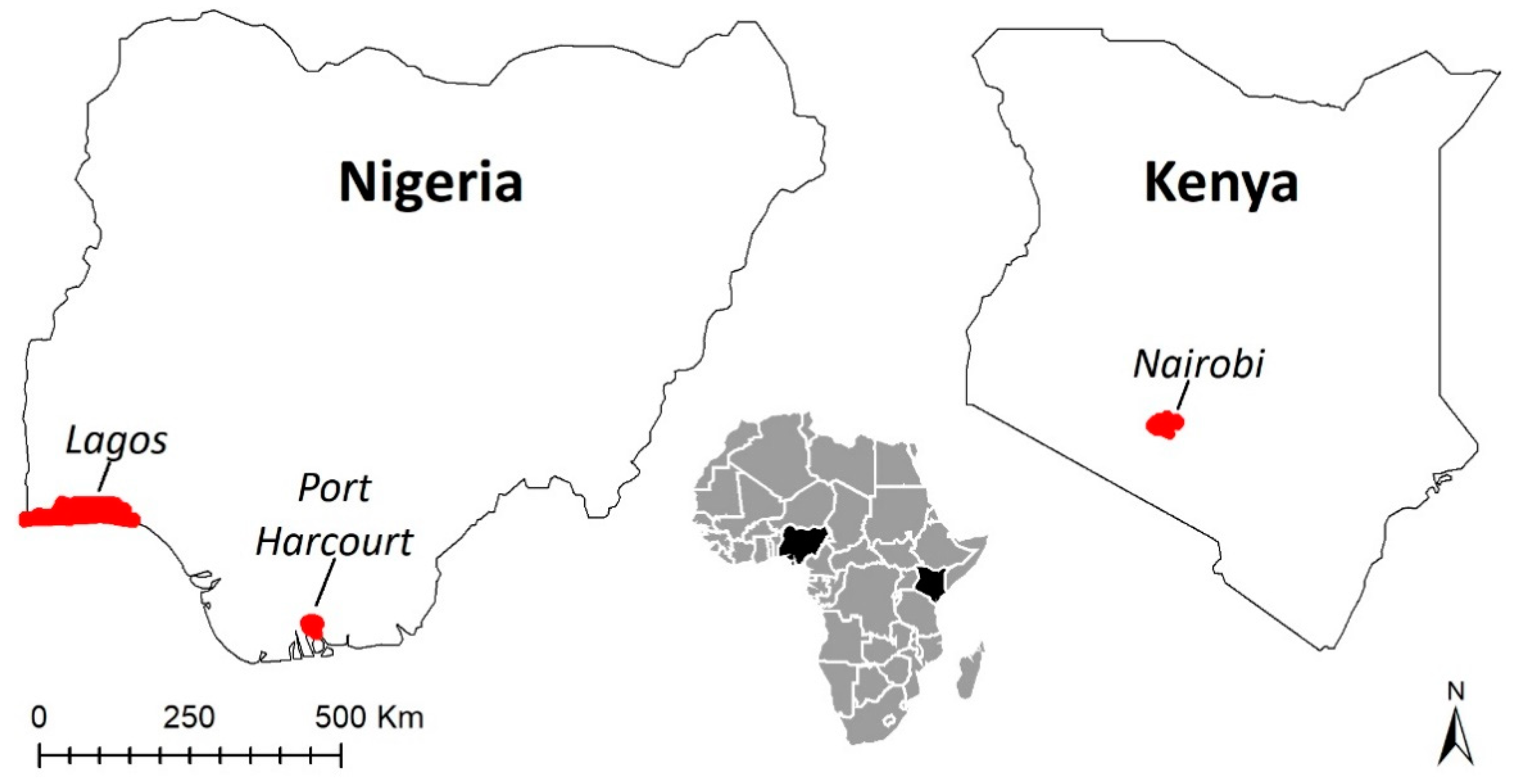
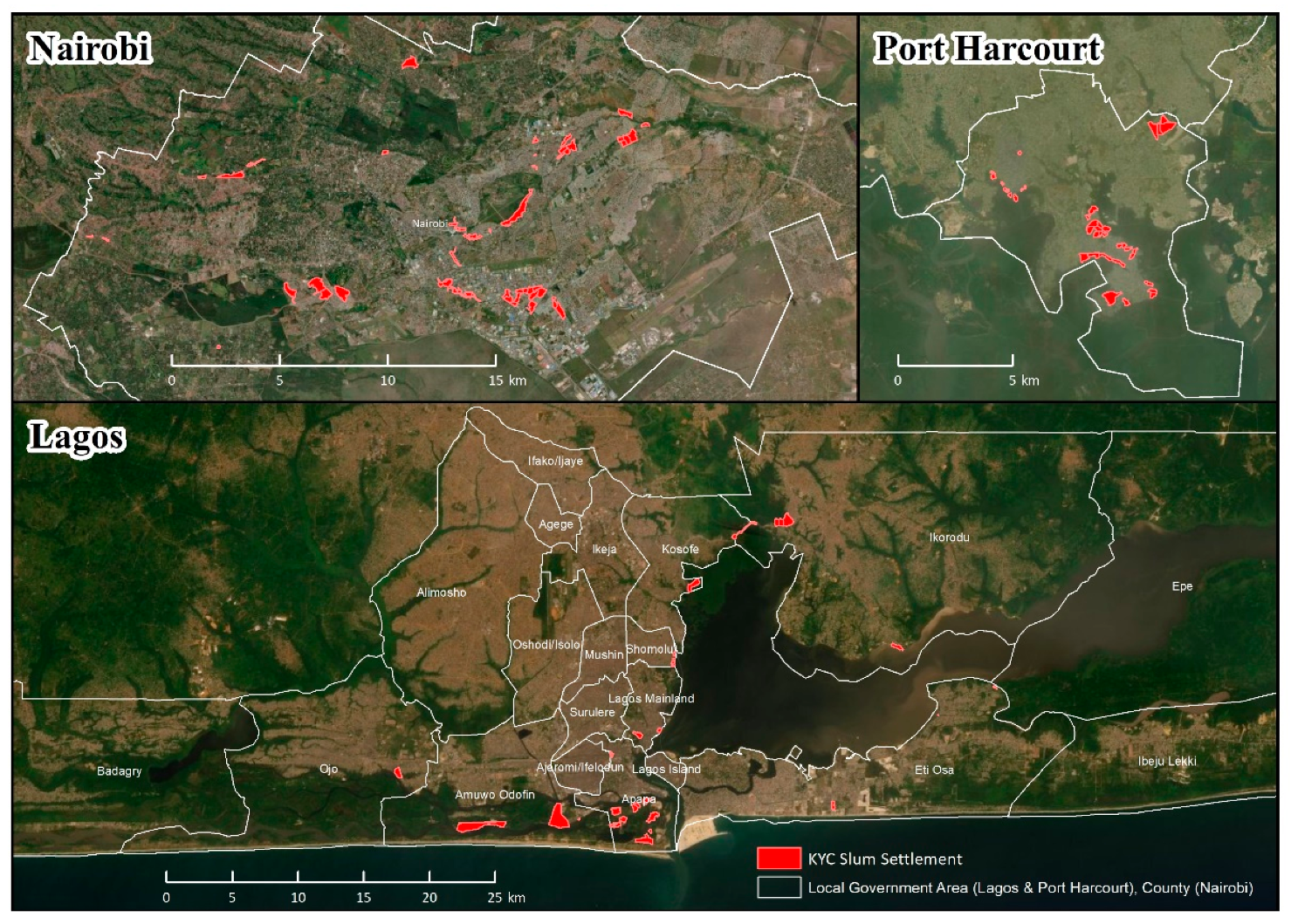

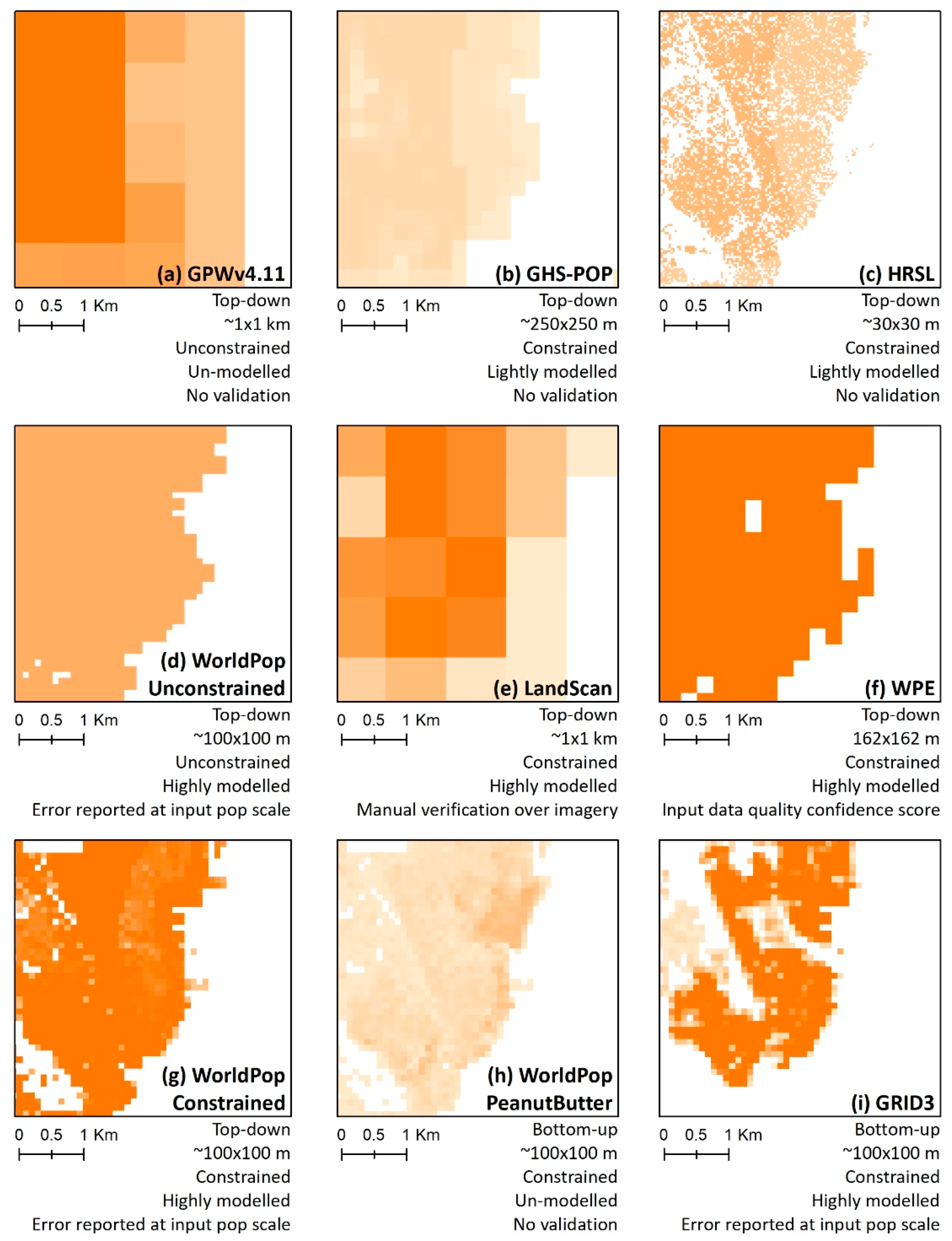
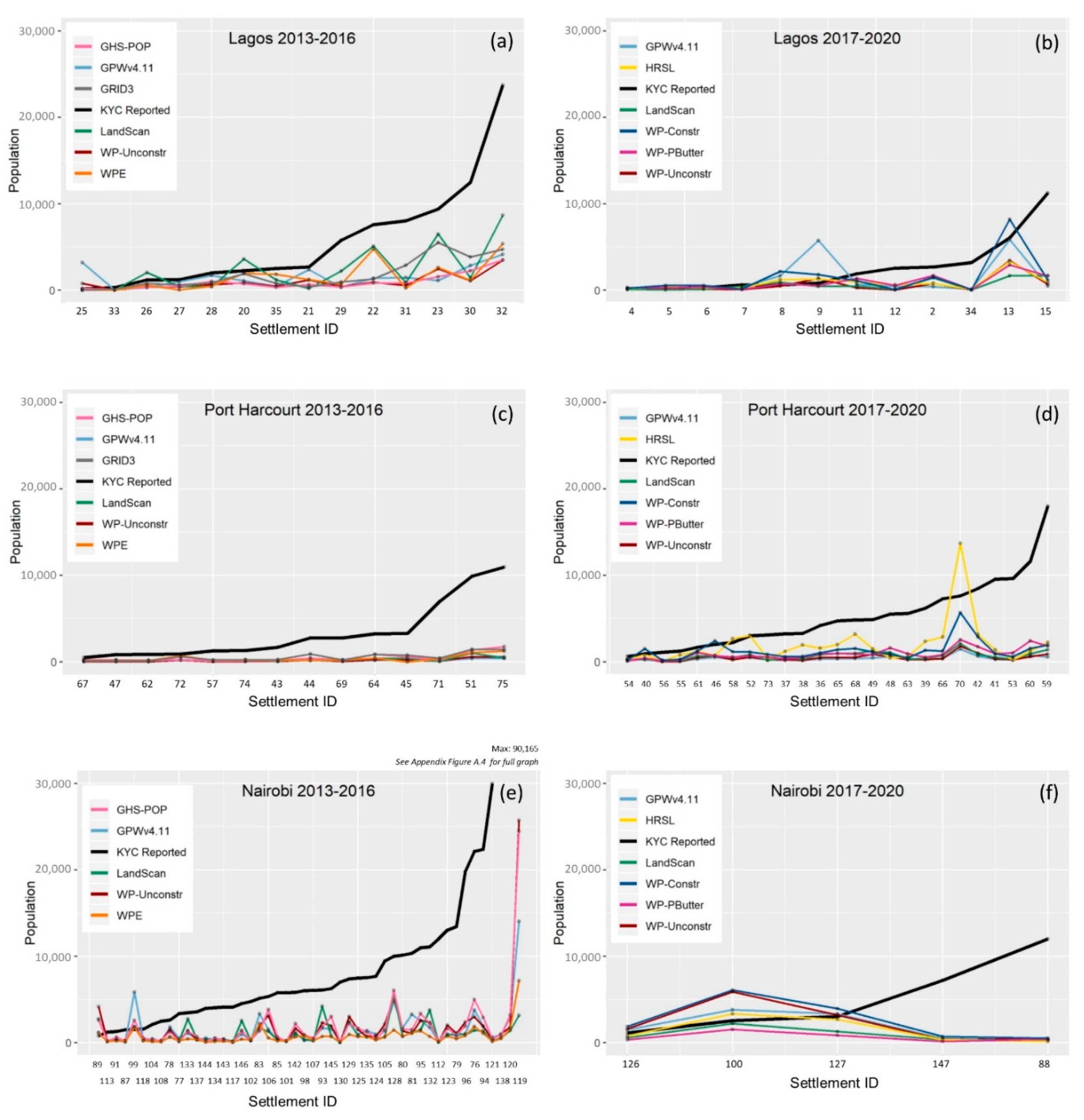
| Dataset | MAE | RMSE | Bias | MF | Dataset Characteristics | ||||
|---|---|---|---|---|---|---|---|---|---|
| HRSL | 3265 | 4958 | −2853 | 0.39 | 2018 | Top-down | Lightly modelled | Constr. | ~30 × 30 m |
| WorldPop Constrained | 3491 | 5001 | −2942 | 0.27 | 2020 | Top-down | Highly modelled | Constr. | ~100 × 100 m |
| GRID3 (Nigeria only) | 3366 | 5296 | −3366 | 0.21 | 2016 | Bottom-up | Highly modelled | Constr. | ~100 × 100 m |
| WorldPop PeanutButter | 3586 | 5073 | −3571 | 0.21 | 2020 | Bottom-up | Un-modelled | Constr. | ~100 × 100 m |
| WorldPop Unconstrained | 6048 | 10,889 | −5899 | 0.11 | 2015, 2018 | Top-down | Highly modelled | Unconstr. | ~100 × 100 m |
| GPW4v.11 | 6189 | 11,482 | −5892 | 0.12 | 2015, 2020 | Top-down | Un-modelled | Unconstr. | ~1 × 1 km |
| LandScan | 6087 | 12,121 | −6032 | 0.12 | 2015, 2018 | Top-down | Highly modelled | Constr. | ~1 × 1 km |
| GHS-POP | 7079 | 12,854 | −7000 | 0.15 | 2015 | Top-down | Lightly modelled | Constr. | ~250 × 250 m |
| WPE | 7653 | 14,422 | −7638 | 0.09 | 2016 | Top-down | Highly modelled | Constr. | 162 × 162 m |
| Dataset | Slum Pop n | Slum Pop % | Total Pop N | Dataset Characteristics | ||||
|---|---|---|---|---|---|---|---|---|
| GRID3 | 293,858 | 2.96 | 9,929,140 | 2016 | Bottom-up | Highly modelled | Constrained | ~100 × 100 m |
| WorldPop PeanutButter | 211,236 | 2.91 | 7,257,126 | 2020 | Bottom-up | Un-modelled | Constrained | ~100 × 100 m |
| LandScan | 336,288 | 1.76 | 19,108,756 | 2018 | Top-down | Highly modelled | Constrained | ~1 × 1 km |
| WorldPop Constrained | 229,446 | 1.73 | 13,254,820 | 2020 | Top-down | Highly modelled | Constrained | ~100 × 100 m |
| HRSL | 233,618 | 1.66 | 14,040,751 | 2018 | Top-down | Lightly modelled | Constrained | ~30 × 30 m |
| WPE | 181,326 | 1.65 | 11,021,596 | 2016 | Top-down | Highly modelled | Constrained | 162 × 162 m |
| GHS-POP | 150,059 | 1.34 | 11,168,526 | 2015 | Top-down | Lightly modelled | Constrained | ~250 × 250 m |
| WorldPop Unconstrained | 161,865 | 1.34 | 12,104,264 | 2018 | Top-down | Highly modelled | Unconstrained | ~100 × 100 m |
| GPW4v.11 | 154,742 | 1.02 | 15,184,176 | 2020 | Top-down | Un-modelled | Unconstrained | ~1 × 1 km |
| UN-Habitat | -- | 56.0 | -- | 2018 | Calculated from 2018 Nigeria DHS [71] using the UN-Habitat “slum household” approach [68] | |||
| Recommendations | GPWv4.11 | GHS-POP | HRSL | WPE | LandScan | WP-Uncontr | WP-Constr | WP-PeanutB |
|---|---|---|---|---|---|---|---|---|
| Classify building footprints or built-up areas as residential versus non-residential | X | X | X | X | X | X | X | |
| Improve GHS-BUILT layer with building footprint data to refine population disaggregation | X | |||||||
| Consider highly modelled methods with use of multiple spatial covariates to inform the allocation of population densities to cells | X | |||||||
Use covariate(s) derived from a building footprint layer, and if possible:
| X | X | X | X | ||||
If (or when) a global layer of deprived areas is developed, either:
| X | X | X | X | X | |||
| Retrain BaseVue on a global dataset, or use an alternative land | X | |||||||
| Use covariates common to other highly modelled datasets, such as roads, nigh time lights, slope, and elevation | X | |||||||
| Use a deprived area layer to update LandScan’s bespoke weighting layer | X | |||||||
| Incorporate KYC population estimates and boundaries (or other slum dataset) in model training data | X | X | ||||||
| Improve building feature extraction algorithms in slums | X |
Publisher’s Note: MDPI stays neutral with regard to jurisdictional claims in published maps and institutional affiliations. |
© 2021 by the authors. Licensee MDPI, Basel, Switzerland. This article is an open access article distributed under the terms and conditions of the Creative Commons Attribution (CC BY) license (https://creativecommons.org/licenses/by/4.0/).
Share and Cite
Thomson, D.R.; Gaughan, A.E.; Stevens, F.R.; Yetman, G.; Elias, P.; Chen, R. Evaluating the Accuracy of Gridded Population Estimates in Slums: A Case Study in Nigeria and Kenya. Urban Sci. 2021, 5, 48. https://doi.org/10.3390/urbansci5020048
Thomson DR, Gaughan AE, Stevens FR, Yetman G, Elias P, Chen R. Evaluating the Accuracy of Gridded Population Estimates in Slums: A Case Study in Nigeria and Kenya. Urban Science. 2021; 5(2):48. https://doi.org/10.3390/urbansci5020048
Chicago/Turabian StyleThomson, Dana R., Andrea E. Gaughan, Forrest R. Stevens, Gregory Yetman, Peter Elias, and Robert Chen. 2021. "Evaluating the Accuracy of Gridded Population Estimates in Slums: A Case Study in Nigeria and Kenya" Urban Science 5, no. 2: 48. https://doi.org/10.3390/urbansci5020048
APA StyleThomson, D. R., Gaughan, A. E., Stevens, F. R., Yetman, G., Elias, P., & Chen, R. (2021). Evaluating the Accuracy of Gridded Population Estimates in Slums: A Case Study in Nigeria and Kenya. Urban Science, 5(2), 48. https://doi.org/10.3390/urbansci5020048








